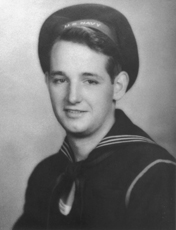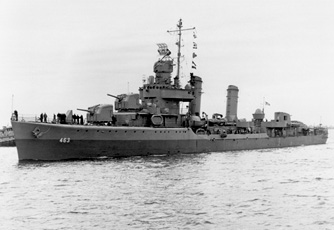
|

|
Elmer Maurer
Machinist Mate, 1st class, USS Corry (DD-463)
While at anchor at Bangor, Ireland near the end of May 1944, I, along with four other crewmembers for the Corry, were detailed to the USS Texas to hear addresses being given by General Dwight D. Eisenhower and other generals and admirals in regards to the upcoming invasion of Europe.
We were informed that the invasion date was close at hand. I can recall Eisenhower stating that we, the Navy, would not have any problems with the German Air Force as we were very superior in that area. If at that time the date of the invasion was mentioned I cannot recall -- however from that day on we were all restricted to the ship, the only people permitted on or off had great clearance.
We returned to Plymouth, England a day or so later and resumed our usual patrols, etc. When we left Plymouth (June 4) heading for the coast of Europe, the sea was very rough/choppy, the going was very slow. We did have a few false submarine contacts, we dropped some depth charges which played havoc with the machinery in the Firerooms and Engine rooms. The Channel being somewhat shallow caused great reverberations in both areas causing gauges, nipples on some of the pumps to split. L.A. Peterson was the machinist mate of the machine shop. He was kept busy turning out new pieces. We then assisted in replacing the same.
Prior to attaining our firing line position, in fact most of the night, there were hundreds of planes carrying paratroopers, bombers dropping bombs - the show was tremendous (if one could call it a show) the pyrotechnics was a sight to behold.
We went to General Quarters early in the morning. My battle station was on the lower level of the forward engine room. I was in charge of the pumps. George Harker, MM 1/class, was also on the lower level in charge of the auxiliary plant and the evaporators. Gullickson was the chief in charge of the forward engine room. Lt. Chehames was the officer in charge. When we arrived at the firing line and opened fire, Harker and I took a turn going top side to see what was going on. After looking at the action we both agreed that we were better off in the secured area of the engine room—that is, until we were hit—then our thoughts certainly changed.
We were answering many bells from the bridge as the ship maneuvered on the line. I and Harker kept hearing sounds of hot metal, a sound that indicates a hot condenser. We checked them very carefully, finally realizing that the sounds were coming from the hull, caused by either sand/shrapnel against the hull.
When we were hit, it was the most awful sound one could ever hear. I was standing by the main lube oil pump on my right, the evaporator on my left. I was thrown into the bilge. The emergency lighting came on giving a small amount of light. I crawled out of the bilge. The small ladder over the starboard shaft was gone. I crawled past the shaft by using the main reduction gear housing. The engine room was in a very destructive state - parts, rails, machinery knocked from its place; oil, water everywhere; steam being released; water from the sea was starting to cover the bilge plate gratings.
When I got to the starboard side of the upper level directly under the escape hatch I noticed a light over by the main turbines. I called as to who was there. It was Bill McConnel who had been checking the area prior to the explosion. I called to Bill to climb over so we could escape, which we did.
As I tried to turn the hatch wheel, it would not turn. The blast had jammed it. It was askew with about an inch opening on the one side. I stuck my fingers through the opening and yelled at the top of my voice. Fortunately I was heard. Men on deck secured a pry bar and forced the hatch open. The hatch was not very wide and the force of the explosion had made it smaller. At the time I weighed 150 pounds. I reached up my arms and was pulled through, my back was scratched up somewhat. McConnel weighed about 180 pounds. Needless to say, when they pulled him through, he was a mess, plus the fact that he had a wound on his leg from a piece of flying steel. All in all, it was a blessing that someone on deck had either heard me or saw my fingers wiggling on the deck. We were both very grateful.
Once on deck I obtained a Mae West life jacket as mine was left in the engine room. We all assisted as needed doing various things such as getting life nets and rafts in the water, and helping the less fortunate in any way we could.
The most serious wounded that I could see at the time were Ski Rovinski, Nick Mitchell, and L. A. Peterson. They all needed special attention from Dr. Andersen and his assistants. Loading them and others was a special job as they were in great pain. To add to the problem, the whale boat would not run, as it was damaged in the battle.
Once in the water I and the others took off swimming away from the ship, trying to make it out to the ships on the outer firing line. The going was very difficult. Headway was out of the question due to the tide and roughness of the Channel. It was a most difficult time -- with the cold sea, the firing of shells at us in the water and men being wounded -- a very, very bad experience to be sure.
We floated around for about two hours, being fired on, suffering from the cold sea. The first ship that came into the area was the USS Fitch (DD-462). It dropped its whale boat and gig. What a welcome sight. The whale boat picked me up, along with many others. Once a load was attained we were taken aboard the Fitch, which went back to the firing line until they expended all their ammunition. The crew of the Fitch treated us with the utmost respect, they could not do enough for us. I shall never forget their kindness.
The Fitch then steamed off the firing line and delivered us to the USS Barnett, a troop ship eight or so miles out. We were transferred to the Barnett, already on board were many soldiers who had arrived back from the beach. The devastation on board was very evident, piles of equipment from the wounded, plus the announcement from the bridge of the Barnett to the small boats, "DO NOT BRING ANY MORE WOUNDED TO THE SHIP AS NO MORE ROOM EXISTS."
Once we got berthed, ate, and cleaned up a bit, Gully, Bill Shepard and I made our way to sick bay and visited with Ski Rovinski. His condition due to the steam scalding was very, very serious. I am sure that we at the time knew that he could not survive.
Before nightfall the Barnett got underway from England. We arrived the next morning. We then were taken to a small hotel to wait for transportation back to Plymouth.
A second brief account by Elmer Maurer from 2002:
I have a lot of memories from the USS Corry. We were dropping depth charges in the Channel, and that was a mess. The water wasn’t that deep, it really shakes things up. My biggest thrill, I was in the lower level of the forward engine room with Grant Gullickson, and when the explosion hit I was thrown into the keel of the ship. And when I got up everything was in disarray with ladders blown away, and I got up to the second level where the engines were and I saw Bill McConnell over there and I said, "C’mon over here Bill. We’ll get out of here." And he said, "We can’t get out." And I said, "The heck we won’t." But he was right, the hatch was jammed and I put my fingers up through the split that was on the deck and they saw that and they took a crowbar and opened it up, and the two of us got out. And I always recall that I weighed about 150 pounds at the time, and Bill weighed about 185 and I know when they pulled me out I just had to put my arms up, but poor Bill, they must have ripped him apart. But the shelling was bad and then we were in the water with all the shrapnel and you felt so not afraid, but the inability to do anything. You knew you had to do something, but there wasn’t really anything you could do. At that time I was 22. And it was, well the one other thing when I saw that whale boat come to rescue me from the USS Fitch, what a blessing.